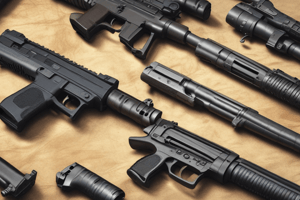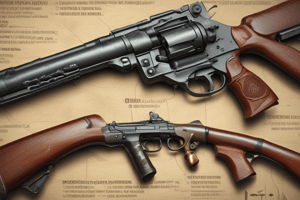Podcast
Questions and Answers
What is the purpose of a forensic comparison microscope?
What is the purpose of a forensic comparison microscope?
- To analyze brass composition in firearm evidence
- To estimate the time of firing based on residue analysis
- To identify the striker pin impression on a bullet casing
- To compare microscopic scratches due to rust or imperfections (correct)
What substance acts as the spark starter or inflammable substance in firearm primer?
What substance acts as the spark starter or inflammable substance in firearm primer?
- Mercuric Fulminate (correct)
- Powdered Glass
- Black Powder
- Potassium Chlorate
Which type of powder is known as 'smokeless powder'?
Which type of powder is known as 'smokeless powder'?
- Black Powder
- Neutral Residue (correct)
- Alkaline Residue
- Powdered Glass
What does the presence of carbon, sulfur, and potassium nitrate in residue indicate?
What does the presence of carbon, sulfur, and potassium nitrate in residue indicate?
What is the purpose of the striker pin impression in firearm evidence analysis?
What is the purpose of the striker pin impression in firearm evidence analysis?
Flashcards
Forensic Comparison Microscope
Forensic Comparison Microscope
Compares microscopic scratches on bullets, caused by rust or imperfections in the gun barrel, to match bullets to a specific firearm.
Mercuric Fulminate
Mercuric Fulminate
A highly sensitive explosive that initiates the firing sequence in a firearm's cartridge.
'Smokeless Powder' Composition
'Smokeless Powder' Composition
Gunpowder that produces minimal smoke upon ignition; composed of nitrocellulose or a combination of nitrocellulose and nitroglycerin.
Carbon, Sulfur, and Potassium Nitrate in Residue
Carbon, Sulfur, and Potassium Nitrate in Residue
Signup and view all the flashcards
Striker Pin Impression
Striker Pin Impression
Signup and view all the flashcards
Study Notes
Classification of Weapons
- Weapons can be classified according to loading into:
- Muzzle loaders
- Breech loaders
Types of Rifles
- RIFLED LONG Auto/Non/Semi/Service Rifle (Military weapon)
- NON-RIFLED SPORTING GUN SHORT REVOLVER (Non-automatic)
- AUTOMATIC PISTOL (automatic)
Classification of Weapons by Barrel Length
- Long gun (≥ 1m)
- Medium gun
- Short gun (≤ 25 cm)
Types of Guns
- بنادق الرش (shotgun)
- (أسلحة الطلق الناريrifle) (only long, non-automatic)
- Gaffer gun
Projectile, Missile, and Ammunition
- Projectile = Missile = Ammunition (المقذوف)
Importance of Rifling
- Reasons for rifling:
- Decrease air resistance
- Decrease specific gravity
- Increase penetration power
- Increase range or distance
Rifling Marks
- Rifling marks or primary marks help identify the:
- Class of weapon (family or type)
- Direction of twisting
- Number of grooves and lands
- Width and depth of grooves
Studying That Suits You
Use AI to generate personalized quizzes and flashcards to suit your learning preferences.




